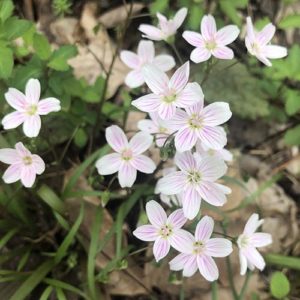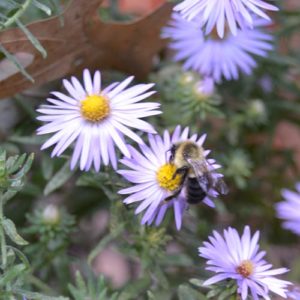When planting for pollinators, the general advice is to have at least three different things blooming throughout the growing season. For most of the spring, this is easy because it seems like everything is in bloom and everyone has some sort of flowering plant in their yard. I could easily fill a whole book with plants that bloom during the spring and are good for pollinators.

The summer is sometimes viewed as being more difficult to plan for than the spring, but is also fairly easy. Coneflowers (Echinacea sp.), sunflowers (Helianthus sp.), cup plant (Silphium perfoliatum), black-eyed Susan (Rudbeckia hirta), cardinal flower (Lobelia cardinalis), blue lobelia (Lobelia siphilitica), passionflower (Passiflora incarnata), shrubby St. John’s wort (Hypericum prolificum), and buttonbush (Cephalanthus occidentalis) are just a few of my favorite summer-blooming native plants. If you bring in vegetables, herbs, and other non-native plants, then the list of possibilities grows even longer.
Early and mid-fall are also easy to plan for when planting for pollinators. Goldenrods (Solidago sp.), ironweeds (Vernonia sp.), joe-pye weeds (Eutrochium sp.), any number of our fall asters (Symphyotrichum sp.), and thoroughworts (Eupatorium sp.) are common native wildflowers that light up the fields and are extremely valuable sources of nectar and pollen. Many of these can be easily incorporated into native plant gardens. However, one word of caution with the goldenrods. Make sure you choose a clump forming species, such as aromatic goldenrod (Solidago odora), for your garden. Most of the species that we see growing in the fields spread by runners and are way too aggressive for the typical garden setting.
But, what about the late fall and the very early spring / late winter? These are often called the “shoulder seasons,” because they are the transition periods into and out of the main growing season. They are also a time period that is often forgotten about when planting for pollinators. It is easy to understand why the shoulder seasons are often forgotten about or ignored. They are much harder to plan for because there aren’t as many options as there are for other times of the year, but they are still important to keep in mind.
In the wild, the late winter / early spring shoulder season (usually late February through late March / early April in Kentucky) is represented by early blooming trees and ephemeral wildflowers. Red maples (Acer sp.), elms (Ulmus sp.), willows (Salix sp.), spring beauty (Claytonia virginica), bloodroot (Sanguinaria canadensis), and bluets (Houstonia sp.) are just a few examples of native plants that bloom during this time period and can be important for pollinators. In fact, many of the spring ephemeral wildflowers have specialist pollinators that depend on that species. In our yards and more developed areas, clover, dandelion, henbit, deadnettle, and other “yard weeds,” as well as some of the trees, can provide valuable nectar and pollen sources during this shoulder season.

The late fall shoulder season (usually October and November in Kentucky) is the hardest to plan for, in my opinion. The growing season is winding down and there just aren’t as many plants that bloom at this time of year. However, when possible, having things available during this time period can be helpful for late flying pollinators like bumble bee queens and honey bees.
My favorite native flower options for the late fall are some of the late blooming native asters like wavy-leaf aster (Symphyotrichum undulatum) and Short’s aster (Symphyotrichum shortii). These can handle a few frosts and I frequently see them blooming into early November – long after the goldenrods and other traditional fall wildflowers have died back. American witch hazel (Hamamelis virginiana) and some of the mistletoes (Phoradendron sp.) are other native examples of plants that bloom during this time period.
The late blooming native asters and American witch hazel can be incorporated into pollinator gardens and other landscape designs. (As a side note, European witch hazel is more common than American witch hazel in the horticulture trade. However, European witch hazel blooms in the late winter / early spring, while American witch hazel blooms in the late fall / early winter.) The traditional “yard weeds” can also help fill the late fall / early winter shoulder season in our yards and more developed areas. Another possibility for providing nectar and pollen sources around our homes during this time period are any herbs or other annuals that we can protect from the frosts.
Planning for the shoulder seasons when planting for pollinators can be more challenging than planning for the primary growing season. If you are just starting your pollinator gardening journey, then my advice is to concentrate your efforts on the primary growing season. Don’t complicate the matter by worrying about the shoulder seasons as you are getting started. Take the easy route and let your “yard weeds” fill in those time periods. However, if you are further along in your journey and are ready for a challenge, then I encourage you to think about ways to provide nectar and pollen sources for our early and late flying pollinators.
Please tell your friends about Backyard Ecology.
(Social media sharing buttons can be found below the footer.)

Backyard Ecology: Exploring Nature in Your Backyard
Nature isn’t just “out there.” It’s all around us, including right outside our doors. Hi, my name is Shannon Trimboli, and I am the host of Backyard Ecology. I live in southcentral Kentucky and am a wildlife biologist, educator, author, beekeeper, and owner of a nursery specializing in plants for pollinators and wildlife conservation. I invite you to join me as we ignite our curiosity and natural wonder, explore our yards and communities, and improve our local pollinator and wildlife habitat. Learn more or subscribe to my email list at www.backyardecology.net.

Leave a Reply